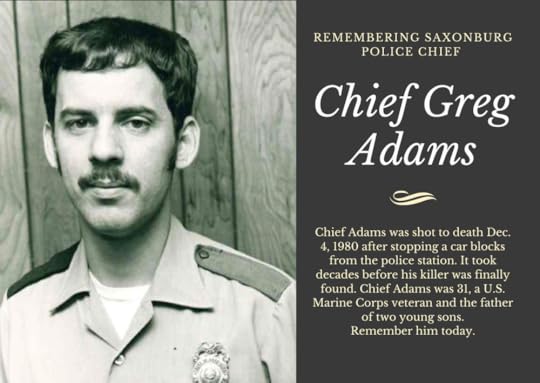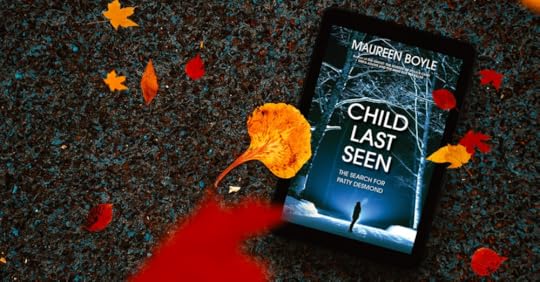Maureen Boyle's Blog
September 6, 2025
A girl on a bike, a life cut short
June 8, 2025
A man of honor
February 14, 2025
Reliving past questions, hoping for future answers

More than 30 years ago, a group of young reporters waited in the cold along the highways ringing New Bedford, Massachusetts as body after body was discovered. Eleven women had gone missing in 1988 and, slowly, they were being found. Some by individuals stopping along the highway, others by cleanup crews, still others by search dogs.
The anguish of the families left behind as the searches, then the identifications, then the investigation dragged on was heartbreaking. The private frustration of the investigators could be seen just below the surface. It was a case that rocked the community. Who killed the women remains unknown.
Some of the reporters from that time are now retired, others died, still others found different jobs. I moved into academia to teach journalism and wrote a true crime book, Shallow Graves: The Hunt for the New Bedford Highway Serial Killer and giving talks on the case. One of the last reporters still actively working in journalism, Bob Ward, still does segments about the case as part of his series, New England's Unsolved, on Boston 25. His most recent piece notes that tips are still coming in to police and police are still working the case. You can watch his segment here: New England's Unsolved
One day we hope we can list this cases as one of New England's Solved.
December 4, 2024
Remembering Chief Greg Adams

December 4 marks the anniversary of the murder of Saxonburg Police Chief Greg Adams at the hands of a crook who escaped justice by hiding in the shadows for decades.
Adams left behind a wife, two young boys and a heartbroken community that refused to forget either his death or the man wanted for his murder.
It was a cold December afternoon in 1980 when the chief stopped a car not far from the police station. What Adams didn't know was the driver, a man named Donald Webb, was a wanted man.
A struggle ensued. Shots were fired. Adams was left mortally wounded behind a home next to the store. His killer sped off.
The suspect was quickly identified and was placed on the FBI Most Wanted list but it would take decades before he would be found.
For those who knew Greg Adams, his memory lives in a community that never forgot and always prayed for justice.
September 14, 2024
Law, grief and justice
The book I'm writing now delves into the dark corners of murder, grief and the toll the criminal justice system takes on families and a community. While it is a haunting story, it is also one that illustrates a single person can make a difference. It can be a cop. It can be a witness. It can be a single juror. It can be a therapist. It can be a child. One voice doesn't call out in a void. It echoes into the community and grows louder.
This story is about loss but it is also about growth.
It is a story about a small community banding together, one by one, to find justice.
No matter how long it takes.
June 30, 2024
The summer of loss
The summer of 1988 was hot. That's what we all remember. It was a summer of beaches, pools, and seeking out air conditioning. No one expected it to also be the summer of grief.
It started on July 3, at least for the public, when the remains of a woman were found along Route 140 northbound in Freetown, a then quiet highway that ended in New Bedford at the corner of a park and zoo. She was found by a passerby who stopped to relieve herself in the bushes. The remains were partially clothed and had no identification. She would remain unidentified for months.
By month's end, on July 30, another body was found, this time on Interstate 195 in nearby Dartmouth, a town to the west of New Bedford, by two men on motorcycles who stopped to relieve themselves in the brush. The woman had no identification. She would also remain unidentified for months.
It would take months, and the reported disappearance of more women, before the community realized a killer lurked in its midst. Eleven women went missing sometime between April or March and September of that year. Nine were found; two remain missing.
In July, we should remember the first two women who were found: Debra Medeiros and Nancy Paiva. We should remember their families, including those members who passed without knowing who was responsible. Remembering is important if whoever is responsible is ever to be identified.


May 9, 2024
The messiness of writing
I do not have a neat desk. I do not have a neat office. Some might even say I work in chaos. But, as fellow clutter-writers may agree, there is organization to those piles of file folders and books on the desk, on the table, on the floor. Yes, I do know (usually) where everything is. I can pull out that stray note or report from what appears to be a random stack.
The state of my desk - and desks over the years - has been a point of contention for editors and a running joke among colleagues. There was a note in my "permanent file" at one newspaper threatening firing if the desk wasn't cleaned. A fire hazard may or may not have been mentioned. It was, after all, during the time when smoking was allowed in newsrooms but I don't really think that was the concern. A fellow reporter at another paper once wrapped my desk with police caution tape. My family just keeps my home office door shut and collectively shake their heads when peering in, hoping it doesn't spread to the rest of the house. Their hopes are dashed regularly.
When I started work at a college with my own office, I pledged to keep my desk neat. After all, there was now lots of space. File cabinets, shelves, drawers - all of the things you need to keep things orderly and tidy. And it worked. For awhile. Like a few months. I did try. I really did. I try to purge the paperwork as much as possible but find the only things I wind up tossing are the very things I need a month later. Once a year, I wheel the blue recycling bin from down the hall to my office, filling it with newspapers (yes, print newspapers), stray paperwork and other associated stuff while old tests go into a separate pile to be shredded. The bin gets filled, part of the desk top can be seen and the rest of the stuff winds up neatly stacked in a corner to be sorted later (at least that's what I tell myself) when there's more time.
The attempt at order often fails, though. Files get misfiled. Paperwork needed to be saved wind up tossed. The order of the disorder is disrupted. Would life and work be easier if everything was neat? Yes, probably, maybe. I have one drawer where notes, lectures, PowerPoint printouts and student handouts for a specific course are organized by week and topic. I've put everything back into the marked hanging files each week. It seems to work. But that drawer is filled with information about the history of journalism, times now stilled on the pages of textbooks. It isn't the one filled with news writing exercises and information about ever changing chaotic world of reporting. Apps bloom and wither (Meerkat and Vine come to mind). Technology (remember Google Glass?) is heralded one season then discontinued the next. The reporting classes will never be neat and orderly because the business like life: a bit messy and always in flux.
I'm hauling that blue bin down the hall again as the semester ends. I know it may fill up but there is much still left and more things to add to the office after the summer. In the meantime, I will be reading and writing and researching and adding to the stacks in my home office while writing my next true-crime book. And I do know where to find each report in the stacks.
November 18, 2023
The missing and the dead

Every year, there are more than 300,000 reports filed of missing children, according to the National Center for Missing and Exploited Children. Some are reports of the same runaways. Some are not. Most turn up alive. But there are those - a small number - who do not.
In my last book, Child Last Seen, I wrote about one of those who didn't come back.
Patty Desmond, a teen-aged girl who went missing In Pennsylvania. She vanished in the 1960s, a time when a number of teens ran off, when parents often had to wait 24 or 48 hours before filing a missing persons report. It was a case that few knew about except for her family and investigators.
Today, I'm researching another case involving a missing teen, one that shook a community to the core, one no one can forget. Her family keeps her memory alive. Those who were children at the time are still haunted by what happened.
Both teens are important. Both cases deserve to be memorialized. Both girls should always be remembered.
October 23, 2023
Delving into the dark side

With each police report, another fact emerges. With each court transcript, another voice rings out. With each news clip, another snippet of the time is memorialized.
The police reports document the evidence but the agony of the victims and a community comes through: a family soon to be grieving, a town frozen in horror, a desperate search for the missing and then the killer.
In each trial, facts emerge but not every nuance, not every piece of information is brought before a jury. A defendant's ar
rest record is often not presented, even if it mirrors the current crime. Some testimony may be deemed hearsay or unduly influenced and not allowed.
The defendant sitting in the courtroom rarely resembles in clothing or demeanor the person who had been arrested. Clothes are fresh. Hair is cut. Tattoos, especially those with expletives or words like "killer," are covered. The jury is looking at a cleaned up person, an image of the neighbor next door they may know. They don't see the handcuffs or the leg irons. They don't see the prison or jail guards waiting to bring them back to the lockup. They are presented the facts of the crime and must decide if there is reasonable doubt the person is guilty.
Too many equate the defendant with the lawyers defending them. Defendants, even those accused of the most repulsive crimes, need counsel during trial. The defense attorneys are not the killers, not the sex offenders, not the robbers. They are the counterweight to prosecutors, making sure justice is equally weighed. They are there to make sure the innocent go free, no matter their past. It is their job to make sure the prosecutors have the evidence to convict. It is their job to keep the justice system honest.
It can be difficult in the midst of horror to understand how lines are drawn in the courtroom. But it is something we all must remember.
September 16, 2023
Stepping into darkness

Researching a true crime book is never easy. You are seeing the crime through the eyes of investigators, of witnesses and the victims. You are also seeing the brutality inflicted by people. You are peering into the dark side of life - and death.
Soon after wrapping up Child Last Seen, I resumed research on a book I was putting off for years. I did some preliminary work - interviewing some witnesses, reading some news articles - but delving into the case was difficult. It is a dark story that touches on the horror inflicted by one man. It is a case that shook a community and shattered hearts. It is a story that needs to be told.
In the upcoming months, I will be reading more about fingerprints, tire tracks and the law. I will be interviewing more people. In those interviews, I won't be reminding people of their pain or resurrecting difficult memories. Those never go away. They are always just below the surface.
When this book is done, I hope people remember the victim, remember evil is where you least expect and sometimes justice takes the long road.



